From zkVM to the Open Proof Market: RISC Zero and Boundless Analysis
Author: 0xjacobzhao
In the blockchain space, cryptography is a core foundation of security and trust. Zero-knowledge proofs (ZK) can compress arbitrarily complex off-chain computations into short proofs that can be efficiently verified on-chain without relying on a trusted third party, while also selectively hiding inputs to protect privacy. With its combination of efficient verification, universality, and privacy, ZK has become a key solution for a wide range of applications, including scalability, privacy, and cross-chain operations. While challenges remain, such as high proof generation overhead and complex circuit development, ZK's engineering feasibility and widespread adoption far surpass other approaches, making it the most widely adopted trusted computing framework.
1. Development History of the ZK Track
The development of zero-knowledge proof (ZK) technology did not happen overnight, but rather took decades of theoretical accumulation and engineering exploration. The overall process can be divided into the following key stages:
1. Theoretical Foundations and Technological Breakthroughs (1980s–2010s): The ZK concept was proposed by MIT scholars Shafi Goldwasser, Silvio Micali, and Charles Rackoff, initially focusing on interactive proof theory. With the emergence of non-interactive zero-knowledge proofs (NIZK) and zk-SNARKs in the 2010s, proof efficiency increased significantly, but early on it still relied on trusted setups.
2. Blockchain Applications (Late 2010s): Zcash introduced zk-SNARKs for private payments, achieving the first large-scale blockchain implementation. However, due to the high cost of proof generation, its practical application scenarios remain limited.
3. Explosive Growth and Expansion (2020s to Present): During this period, ZK technology fully entered the mainstream of the industry:
- ZK Rollup: Through off-chain batch calculations and on-chain proofs, it achieves high throughput and secure inheritance, becoming the core path for Layer 2 expansion.
- zk-STARKs: StarkWare launches zk-STARKs to eliminate trusted setup and improve transparency and scalability.
- zkEVM: Teams such as Scroll, Taiko, and Polygon are committed to seamless migration of EVM bytecode-level proofs and existing Solidity applications.
- General zkVM: RISC Zero, Succinct SP1, Delphinus zkWasm, etc. support verifiable execution of arbitrary programs, expanding ZK from a capacity expansion tool to a "trusted CPU".
- zkCoprocessor encapsulates zkVM as a coprocessor, supporting complex logic outsourcing (such as RISC Zero Steel and Succinct Coprocessor);
- zkMarketplace markets proof-of-stake computing power, forming a decentralized prover network (such as Boundless), and promoting ZK to become a ubiquitous computing layer.
ZK technology has evolved from an obscure cryptographic concept into a core module of blockchain infrastructure. It not only supports scalability and privacy protection, but also demonstrates strategic value in cutting-edge scenarios such as cross-chain interoperability, financial compliance, and artificial intelligence (ZKML). With the continuous improvement of its toolchain, hardware acceleration, and proof network, the ZK ecosystem is rapidly moving towards scale and ubiquity.
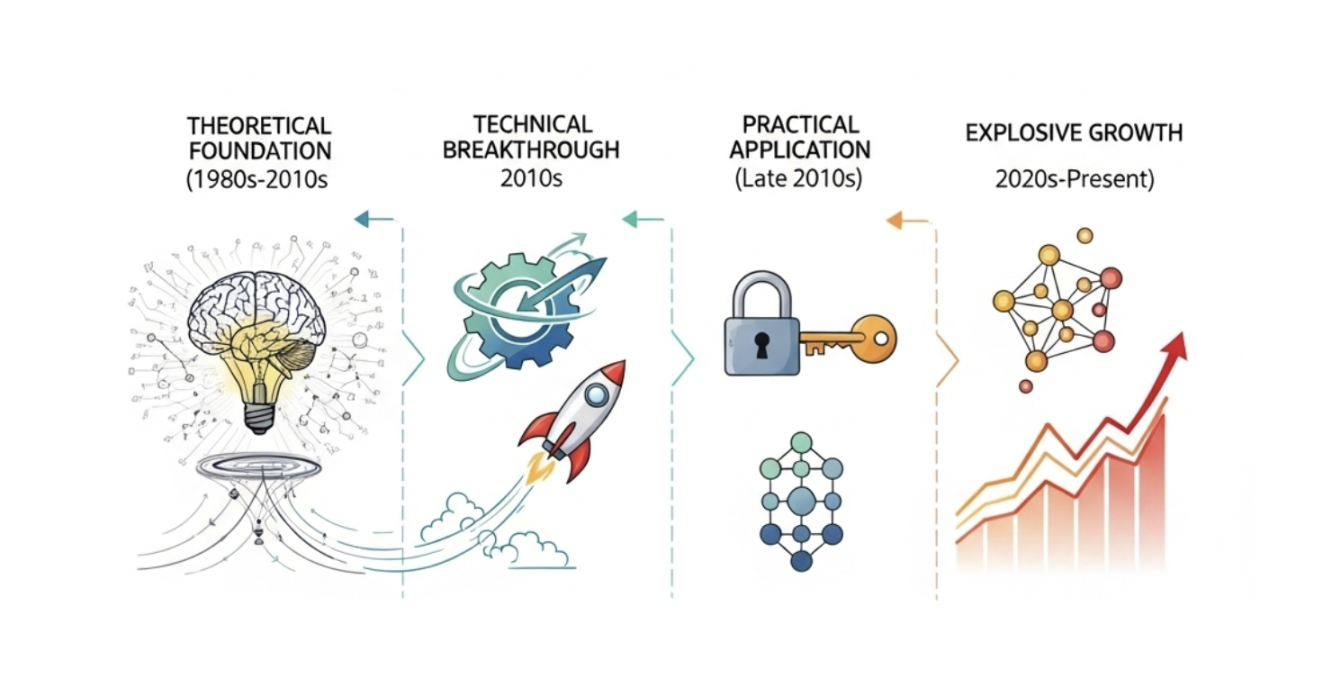
2. ZK Technology Application Panorama: Scaling, Privacy, and Interoperability
Scalability, privacy, and interoperability and data integrity are the three basic scenarios of ZK "trusted computing" technology, corresponding to the original pain points of insufficient blockchain performance, lack of privacy, and multi-chain mutual trust.
- Scalability is the earliest and most widely used use case for ZK. Its core concept is to move transaction execution off-chain and verify it on-chain using concise proofs, significantly improving transaction throughput and reducing costs without sacrificing security. Typical approaches include: zkRollup (zkSync, Scroll, Polygon zkEVM), which achieves scalability through batched transaction compression; zkEVM, which builds circuits at the EVM instruction level for native Ethereum compatibility; and the more general zkVM (RISC Zero, Succinct), which supports verifiable outsourcing of arbitrary logic.
- Privacy aims to prove the legitimacy of transactions or actions while avoiding the exposure of sensitive data. Typical applications include: private payments (Zcash, Aztec), which guarantee the validity of fund transfers without disclosing the amount or counterparty; private voting and DAO governance, which enable governance without revealing the content of votes; and private identity/KYC (zkID, zkKYC), which simply proves "eligibility" without disclosing additional information.
- Interoperability and data integrity are key aspects of ZK technology's approach to resolving trust challenges in a multi-chain world. By generating proof of another chain's state, cross-chain interactions can eliminate the need for centralized relays. Typical implementations include zkBridge (cross-chain state proof) and light client verification (efficient verification of source chain block headers on the target chain), with projects like Polyhedra and Herodotus demonstrating this. ZK is also widely used for data and state proofs, such as zkQuery/zkSQL in Axiom and Space and Time, as well as data integrity verification in IoT and storage scenarios, ensuring the trustworthiness of off-chain data on-chain.
Building on these three foundational scenarios, ZK technology has the potential to expand into a wider range of industry applications in the future: including AI (zkML), generating verifiable proofs for model reasoning or training, enabling "trusted AI"; financial compliance, such as exchange Proof of Reserves (PoR), clearing, and auditing, to reduce trust costs; and gaming and scientific computing, ensuring the authenticity of logic and experimental results in GameFi or DeSci. Essentially, these are all extensions of "verifiable computing + data proof" across various industries.
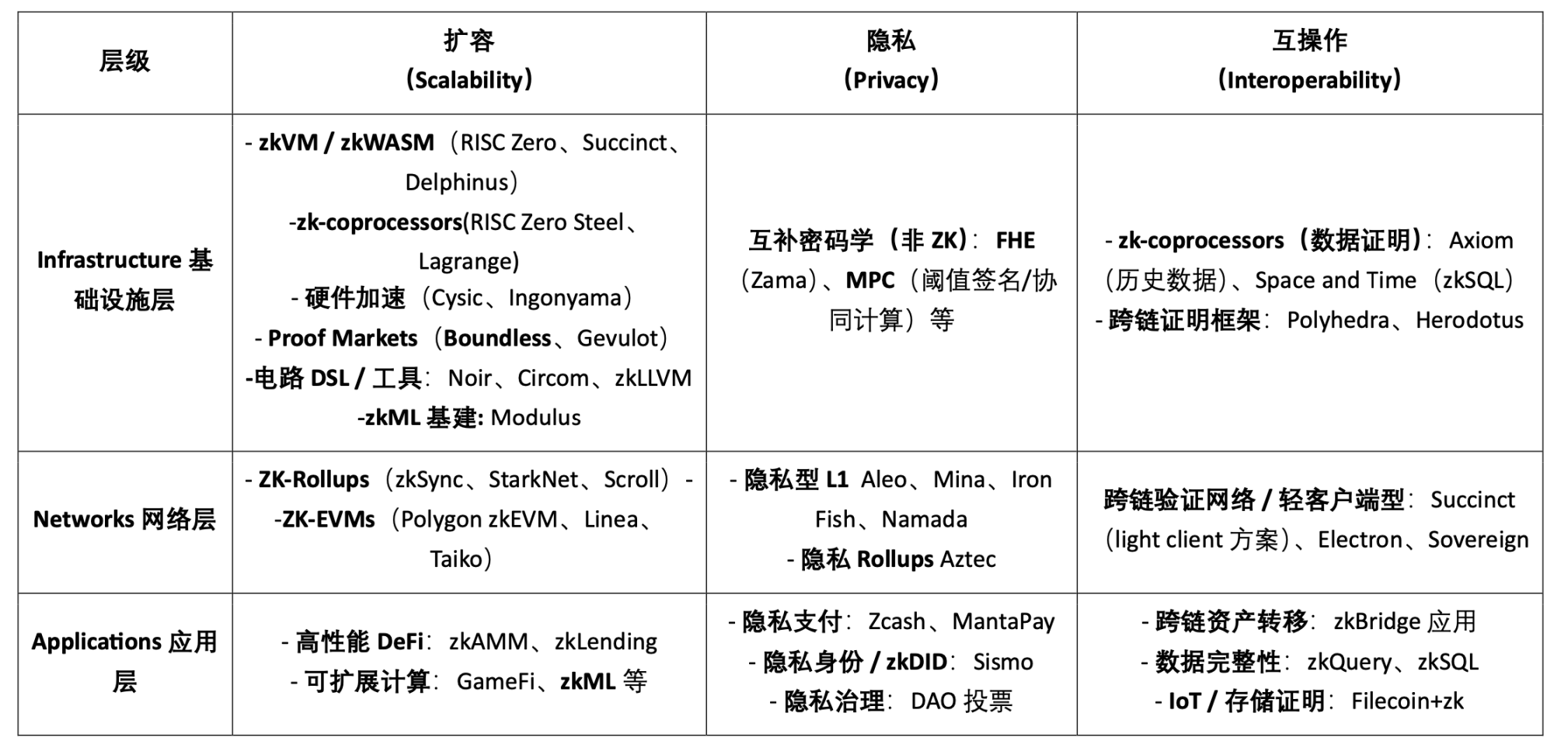
Beyond zkEVM: Universal zkVM and the Rise of the Proof Market
The four-category classification of ZK-EVM (Type 1–4) proposed by Ethereum founder Vitalik in 2022 reveals the trade-off between compatibility and performance:
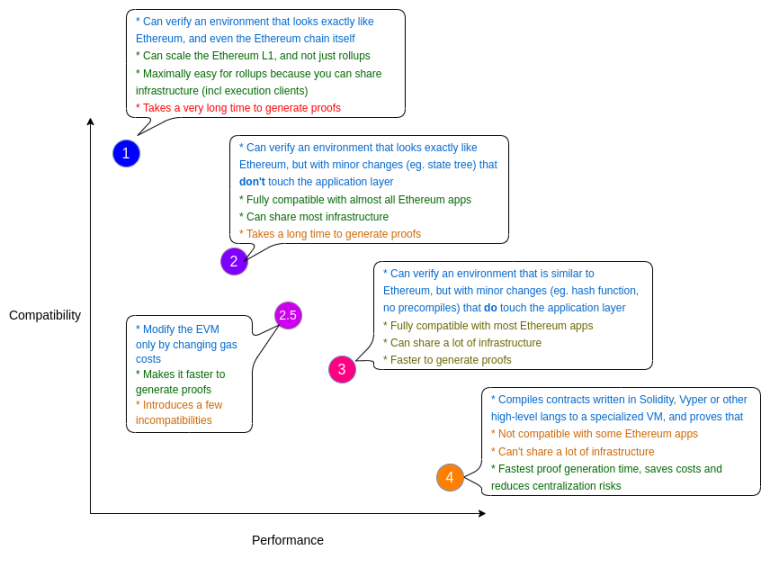
- Type 1 (Complete Equivalence): Bytecode is identical to Ethereum L1, offering the lowest migration cost but the slowest verification. Representative project: Taiko.
- Type 2 (Fully Compatible): Maintains a high degree of EVM equivalence, with minimal underlying optimizations, offering the highest compatibility. Representative projects include Scroll and Linea.
- Type 2.5 (quasi-compatible): Minor EVM modifications (such as gas costs and precompilation support) sacrifice a small amount of compatibility in exchange for performance improvements. Representative projects: Polygon zkEVM and Kakarot (EVM running on Starknet).
- Type 3 (Partial Compatibility): This approach involves more thorough modifications to the underlying infrastructure, allowing it to run most applications but unable to fully reuse Ethereum infrastructure. Representative projects include zkSync Era.
- Type 4 (language-level compatibility): Abandoning bytecode compatibility, compiling directly from high-level languages to zkVM offers the best performance but requires ecosystem reconstruction. Representative projects include Starknet (Cairo).
The theme of this phase was the "zkRollup War," aimed at alleviating Ethereum's execution bottlenecks. However, two major limitations emerged: first, the difficulty of circuitizing the EVM, limiting proof efficiency; second, ZK's potential far exceeded capacity expansion, extending to cross-chain verification, data proofs, and even AI computing.
Against this backdrop, the general-purpose zkVM has emerged, replacing the Ethereum-compatible approach of zkEVM with a focus on chain-agnostic trusted computing. Based on general-purpose instruction sets (such as RISC-V, LLVM IR, and Wasm), zkVM supports languages like Rust and C/C++, allowing developers to build arbitrary application logic using mature ecosystem libraries and verify it on-chain through proofs. RISC Zero (RISC-V) and Delphinus zkWasm (Wasm) are typical examples. The significance of this approach lies in the fact that zkVM is not just an Ethereum scaling tool, but the "trusted CPU" of the ZK world.
- RISC-V: Represented by RISC Zero, this approach directly selects the open, general-purpose RISC-V instruction set as the zkVM's execution core. Its advantages include an open ecosystem, a concise instruction set, and ease of circuit implementation. It can compile code from mainstream languages like Rust, C, and C++, making it suitable for use as a "general-purpose zkCPU." However, its disadvantage is that it lacks native compatibility with Ethereum bytecode and requires integration into a coprocessor.
- LLVM IR route: represented by Succinct SP1: the front end uses LLVM IR for compatibility with multiple languages, and the back end is still based on RISC-V zkVM. In essence, it is "LLVM front end + RISC-V back end". It is more versatile than the pure RISC-V mode, but the LLVM IR instructions are complex and the proof overhead is greater.
- Wasm: Delphinus zkWasm is a representative example. The WebAssembly ecosystem is mature, developers are familiar with it, and it is naturally cross-platform. However, the Wasm instruction set is relatively complex, which limits its performance.
As ZK technology evolves, it is moving towards modularization and marketization. First, the zkVM provides a universal trusted execution environment, the equivalent of a "CPU/compiler" for zero-knowledge computation, providing underlying verifiable computing power for applications. Furthermore, the zk-coprocessor encapsulates the zkVM as a coprocessor, enabling chains like the EVM to outsource complex computational tasks to off-chain execution and verify them back on-chain through zero-knowledge proofs. Typical examples include RISC Zero Steel and Lagrange, which can be compared to a "GPU/coprocessor." Furthermore, the zkMarketplace enables the market-based distribution of proof tasks through a decentralized network. Prover nodes around the world complete tasks through bidding, such as Boundless, building a computing power market for zero-knowledge computation.
As a result, the zero-knowledge technology stack has evolved from zkVM to zk-coprocessor to zkMarketplace. This system marks the evolution of zero-knowledge proofs from a single Ethereum scaling tool to a universal trusted computing infrastructure. Within this evolutionary chain, RISC Zero, with RISC-V as the zkVM core, strikes an optimal balance between openness, circuit efficiency, and ecosystem adaptability. This allows it to provide a low-barrier development experience while also enabling the evolution of zkVM into a zk-coprocessor and a decentralized proof market through extension layers like Steel, Bonsai, and Boundless, opening up a broader range of applications.
RISC Zero's Technology Path and Ecosystem
RISC-V is an open, royalty-free instruction set architecture (ISA) not controlled by a single vendor and inherently decentralized. Leveraging this open architecture, RISC Zero has built a zkVM compatible with general-purpose languages like Rust. This breaks the limitations of Solidity within the Ethereum ecosystem, enabling developers to directly compile standard Rust programs into applications capable of generating zero-knowledge proofs. This approach expands the application of ZK technology beyond blockchain contracts to the broader field of general-purpose computing.
RISC0 zkVM: A Universal Trusted Computing Environment
Unlike the zkEVM project, which requires compatibility with the complex EVM instruction set, the RISC0 zkVM, based on the RISC-V architecture, is designed to be more open and versatile. Its application consists of guest code compiled into an ELF binary. The host runs it through the Executor, which records the execution process (session). The Prover then generates a verifiable receipt containing the public output (journal) and a cryptographic proof (seal). Third parties can verify the correctness of the computation simply by verifying the receipt, without having to re-execute the computation.
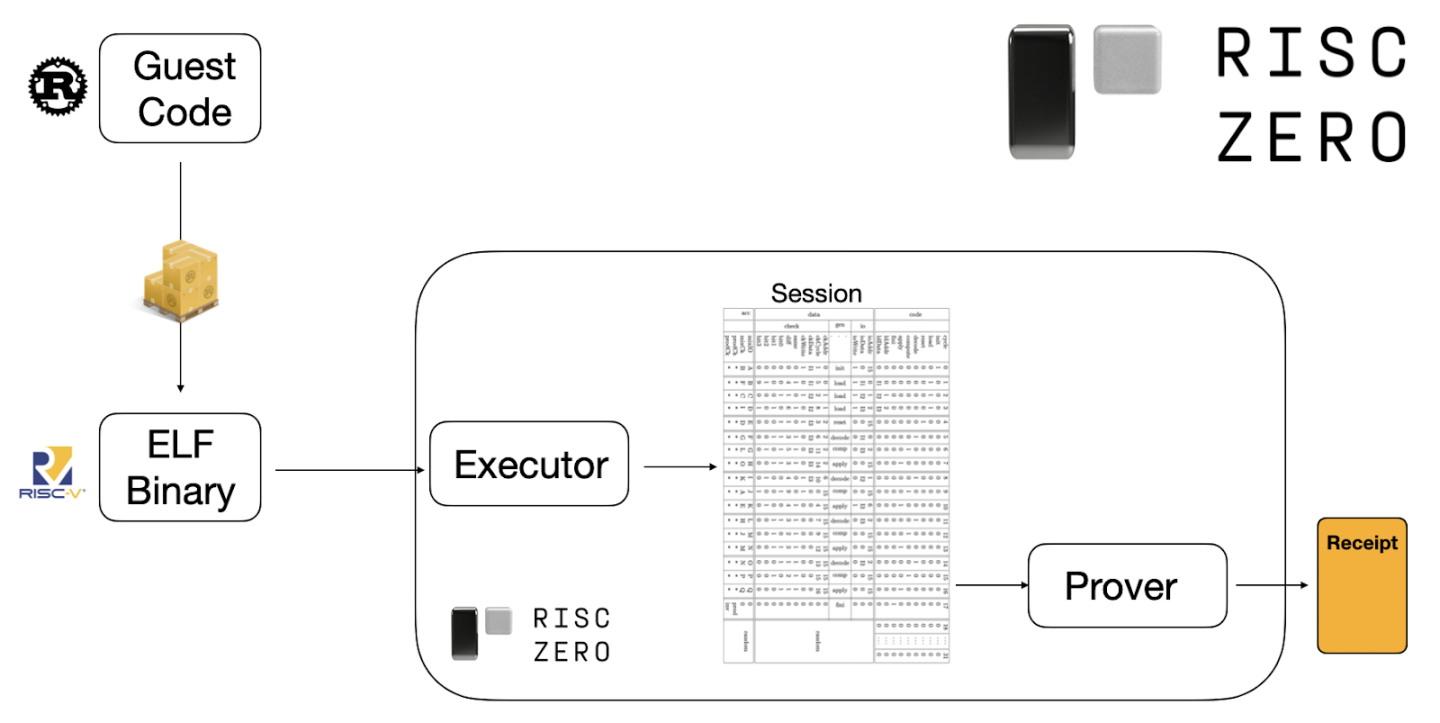
The release of R0VM 2.0 in April 2025 marked the entry of zkVM into the real-time era: Ethereum block proof time was reduced from 35 minutes to 44 seconds, costs were reduced by up to 5x, and user memory was expanded to 3GB, supporting more complex application scenarios. It also added two key precompilers, BN254 and BLS12-381, fully covering mainstream Ethereum requirements. More importantly, R0VM 2.0 introduced formal verification for security and has completed deterministic verification of most RISC-V circuits. The goal is to achieve the first block-level real-time zkVM (proofs in <12 seconds) by July 2025.
zkCoprocessor Steel: A Bridge for Off-Chain Computation
The core concept of the zkCoprocessor is to offload complex computational tasks from on-chain to off-chain execution, returning results via zero-knowledge proofs. Smart contracts only need to verify proofs without recalculating the entire task, significantly reducing gas costs and breaking performance bottlenecks. For example, RISC0's Steel provides an external proof interface for Solidity, enabling outsourcing of large-scale historical state queries or cross-block batch computations. It can even verify dozens of Ethereum blocks with a single proof.
Bonsai: SaaS-based high-performance proof service
To meet the needs of industrial-grade applications, RISC Zero launched Bonsai, an officially hosted Prover-as-a-Service platform. This platform distributes proof tasks across GPU clusters, allowing developers to achieve high-performance proofs without having to build their own hardware. RISC Zero also offers the Bento SDK, which enables seamless interaction between Solidity and the zkVM, significantly reducing the complexity of zkCoprocessor integration. In contrast, Boundless achieves decentralized proofs through an open marketplace, creating a complementary platform.
RISC Zero Full Product Matrix
RISC Zero's product ecosystem extends upward around zkVM, gradually forming a complete matrix covering the execution, network, market, and application layers:
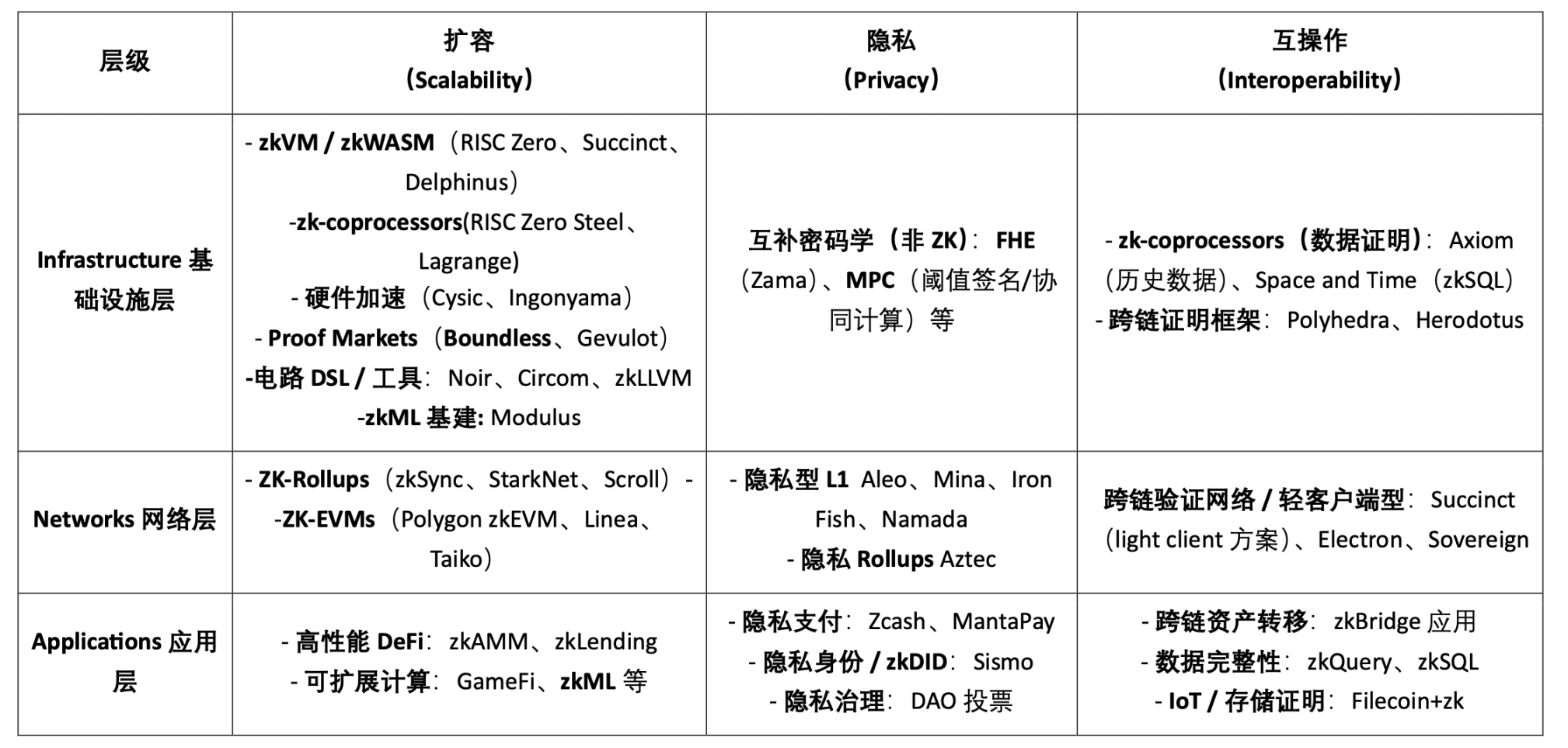
5. ZK Market: Decentralized Commoditization of Trusted Computing
The zero-knowledge proof (ZK) market decouples the costly and complex proof generation process and transforms it into a decentralized, tradable computing commodity. Through a globally distributed network of provers, computing tasks are outsourced through bidding, dynamically balancing cost and efficiency. Economic incentives are used to continuously attract GPU and ASIC participants, creating a self-reinforcing cycle. Boundless and Succinct are representative examples of this sector.
5.1 Boundless: General Zero-Knowledge Computing Market
Concept Positioning
Boundless is a general-purpose ZK protocol developed by RISC Zero, designed to provide scalable verifiable compute capabilities for all blockchains. Its core principle is to decouple proof generation from blockchain consensus and distribute computational tasks through a decentralized market mechanism. After developers submit proof requests, Prover nodes compete to execute them through a decentralized incentive mechanism and are rewarded for their "Proof of Verifiable Work." Unlike traditional PoW, which wastes computational power in vain, Boundless converts computational power into ZK results for real applications, making computational resources truly valuable.
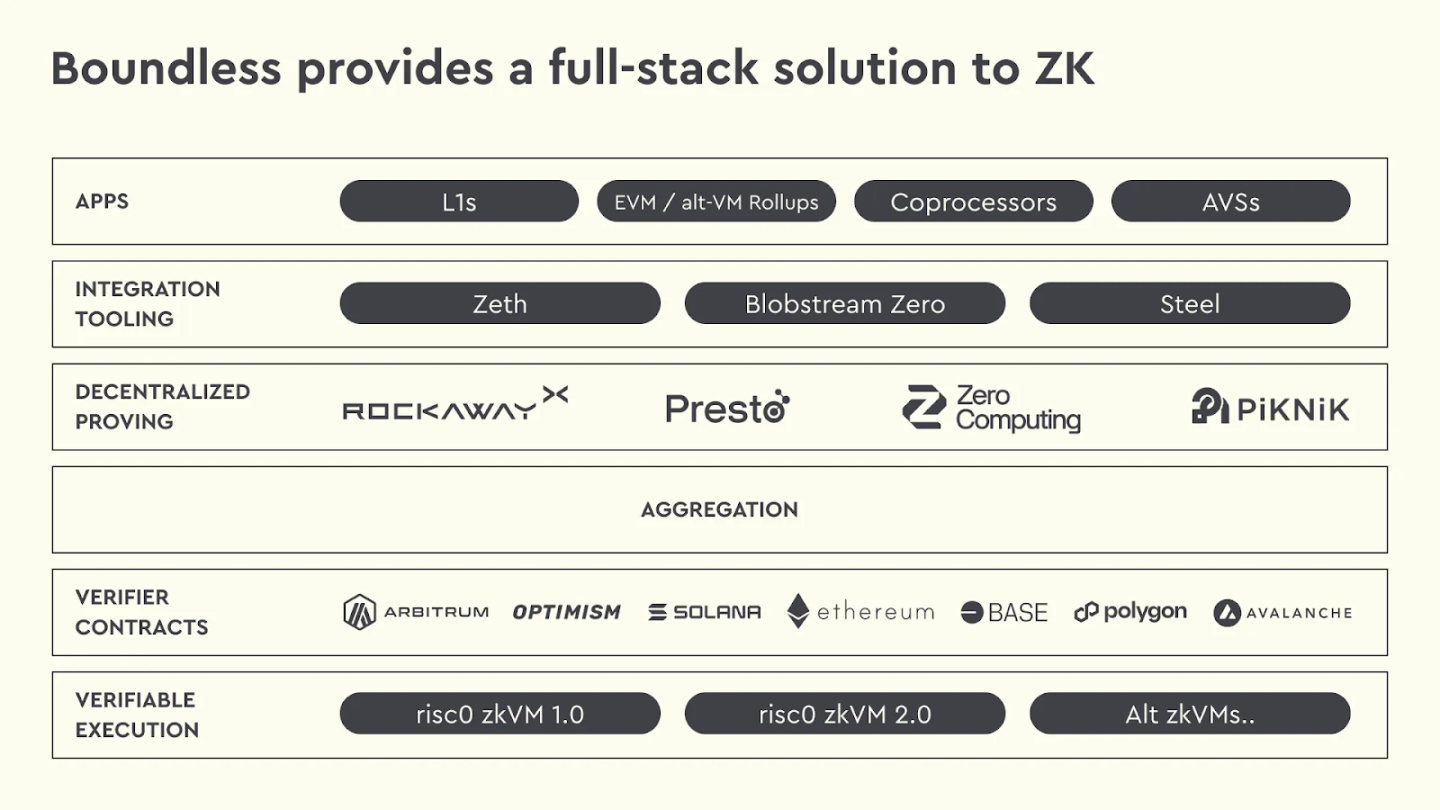
Architecture and Mechanism
The workflow of the Boundless Marketplace includes:
- Request submission: Developers submit zkVM programs and inputs to the market;
- Node bidding: Prover nodes evaluate tasks and bid, then obtain execution rights after locking the tasks;
- Proof Generation and Aggregation: Complex computations are broken down into subtasks, each of which generates a zk-STARK proof. These are then compressed into a unified final proof through recursion and aggregation circuits, significantly reducing on-chain verification costs.
- Cross-chain verification: Boundless provides a unified verification interface on multiple chains, enabling one-time build and cross-chain reuse
This architecture eliminates the need for smart contracts to repeatedly perform complex calculations, and allows confirmation to be completed by simply verifying short proofs, thereby breaking through the gas limit and block capacity limitations.
Ecosystem and Applications: As a market-level protocol, Boundless complements other RISC Zero products:
- Steel: ZK Coprocessor for the EVM, which moves complex Solidity execution off-chain and verifies it back on-chain.
- OP Kailua: Provides a ZK upgrade path for the OP Stack chain, achieving higher security and faster finality.
Boundless aims to achieve sub-12-second real-time proofs on Ethereum through a combination of FRI optimization, polynomial parallelization, and VPU hardware acceleration. As nodes and demand grow, Boundless will form a self-reinforcing computing power network, reducing gas costs and enabling new application scenarios such as on-chain verifiable AI, cross-chain liquidity, and unlimited computation.
5.2 Boundless for Apps: Breaking Gas Limits
Boundless for Apps aims to provide "unlimited computing power" for Ethereum and Layer 2 applications, offloading complex logic to a decentralized proof network for execution, and then verifying it back on-chain using ZK proofs. Its advantages include unlimited execution, constant gas costs, compatibility with Solidity/Vyper, and native cross-chain support.
Steel, as the EVM's ZK coprocessor, enables developers to implement large-scale state queries, cross-blockchain computations, and event-driven logic within Solidity contracts. It also enables cross-chain data verification between ETH and OP Stack via the R0-Helios light client. Projects including EigenLayer are exploring integration with Steel, demonstrating its potential for DeFi and multi-chain interactions.
Steel: A Scalable Computation Layer for the EVM
Steel's core goal is to overcome Ethereum's limitations in gas usage, single-block execution, and historical state access by migrating complex logic off-chain and verifying it back on-chain through zero-knowledge proofs. While ensuring security, it provides nearly unlimited computing power with a constant verification overhead.
In Steel 2.0, developers can expand the contract design space by leveraging three key capabilities:
- Event-driven logic: directly uses event logs as input, avoiding reliance on centralized indexers;
- Historical status query: access the storage slot or account balance of any block since the Dencun upgrade;
- Cross-block computation: Execute operations (such as moving averages and cumulative indicators) across multiple blocks and submit them on-chain with a single proof.
This design significantly reduces costs. The emergence of Steel has enabled applications that were originally limited by EVM (such as high-frequency computing, state backtracking, or cross-block logic) to be implemented, and has gradually become a key bridge connecting off-chain computing and on-chain verification.
5.3 Boundless for Rollups: A ZK-driven Rollup Acceleration Solution
Boundless for Rollups provides a faster and more secure settlement path for second-layer chains like OP Stack through a decentralized proof network. Its core advantages are:
- Accelerated finality: Reduces 7-day settlement time by approximately 3 hours (Hybrid mode) or <1 hour (Validity mode);
- Stronger security: Provide cryptographic-grade security through progressive upgrades to ZK Fraud Proof and Validity Proof
- Decentralized Evolution: Relying on a distributed Prover network and low collateral requirements, rapidly moving towards Stage 2 decentralization;
- Native Scalability: Maintain stable performance and predictable costs on high-throughput chains.
OP Kailua: Providing a ZK upgrade path for OP chains
As the core solution of Boundless for Rollups, OP Kailua was launched by RISC Zero and is designed specifically for Optimism-based Rollups, enabling the team to surpass traditional OP architecture in performance and security.
Kailua provides two modes to support gradual upgrades:
- Hybrid Mode (ZK Fraud Proof): ZK Fraud Proof replaces multiple rounds of interactive Fault Proof, significantly reducing the complexity and cost of dispute resolution. Proof costs are borne by the malicious party, and finality is shortened to approximately 3 hours.
- Validity Mode (ZK Validity Proof): Directly transforms to ZK Rollup, using zero-knowledge validity proof to completely eliminate disputes, achieve <1 hour finality, and provide the highest level of security.
Kailua supports a smooth upgrade path for OP Chains from Optimistic to Hybrid to ZK Rollup, meeting Stage 2 decentralization requirements. This lowers the upgrade barrier and improves economic efficiency in high-throughput scenarios. While maintaining the continuity of existing applications and toolchains, the OP ecosystem can gradually achieve rapid finality, lower staking costs, and enhanced security. Eclipse has leveraged Kailua to implement ZK Fraud Proof, accelerating its upgrade, while BOB has completed its transition to ZK Rollup.
5.4 The Signal: ZK Signaling Layer for Cross-Chain Interoperability
Positioning and Mechanism
The Signal is Boundless' core application—an open-source ZK consensus client. It compresses the finality events of the Ethereum Beacon Chain into a single zero-knowledge proof that can be directly verified by any chain or contract, enabling trust-minimized cross-chain interactions without the need for multisig or oracles. Its value lies in making Ethereum's final state globally readable, paving the way for cross-chain liquidity and logical interactions, while significantly reducing redundant computation and gas costs.
Operating Mechanism
- Boost The Signal: Users can "boost the signal" by submitting proof requests. All ETH is directly used to request new proofs, extending the duration of the signal and benefiting all chains and applications.
- Prove The Signal: Anyone can run a Boundless Prover node to generate and broadcast ZK proofs for Ethereum blocks, replacing traditional multi-signature verification and forming a cross-chain consensus layer that "replaces trust with mathematics."
- Expansion path: First, generate continuous proofs for Ethereum's finalized blocks to form the "Ethereum signal"; then extend it to other public chains to build a multi-chain unified signal; finally, interconnect on the same cryptographic signal layer to form a "shared wavelength" to achieve cross-chain interoperability without packaged assets and centralized bridges.
Currently, over 30 teams are participating in the development of The Signal. Over 1,500 Prover nodes have been aggregated on the Boundless market, competing for 0.5% of token incentives. Anyone with a GPU can join without permission. The Signal is now live on the Boundless mainnet Beta and supports production-grade proof requests based on Base.
VI. Boundless Roadmap, Mainnet Progress, and Ecosystem
Boundless's development follows a clear phased path:
- Phase I – Developer Access: Open early access to developers, providing free proof resources to accelerate application exploration;
- Phase II – Public Testnet 1: Launching the public testnet, introducing a two-sided market mechanism, and allowing developers to interact with Prover nodes in a real-world environment.
- Phase III – Public Testnet 2: Introducing market incentives and a complete economic mechanism to test a self-sustaining decentralized proof-of-stake network;
- Phase IV – Mainnet: Full mainnet launch, providing universal ZK computing capabilities for all chains.
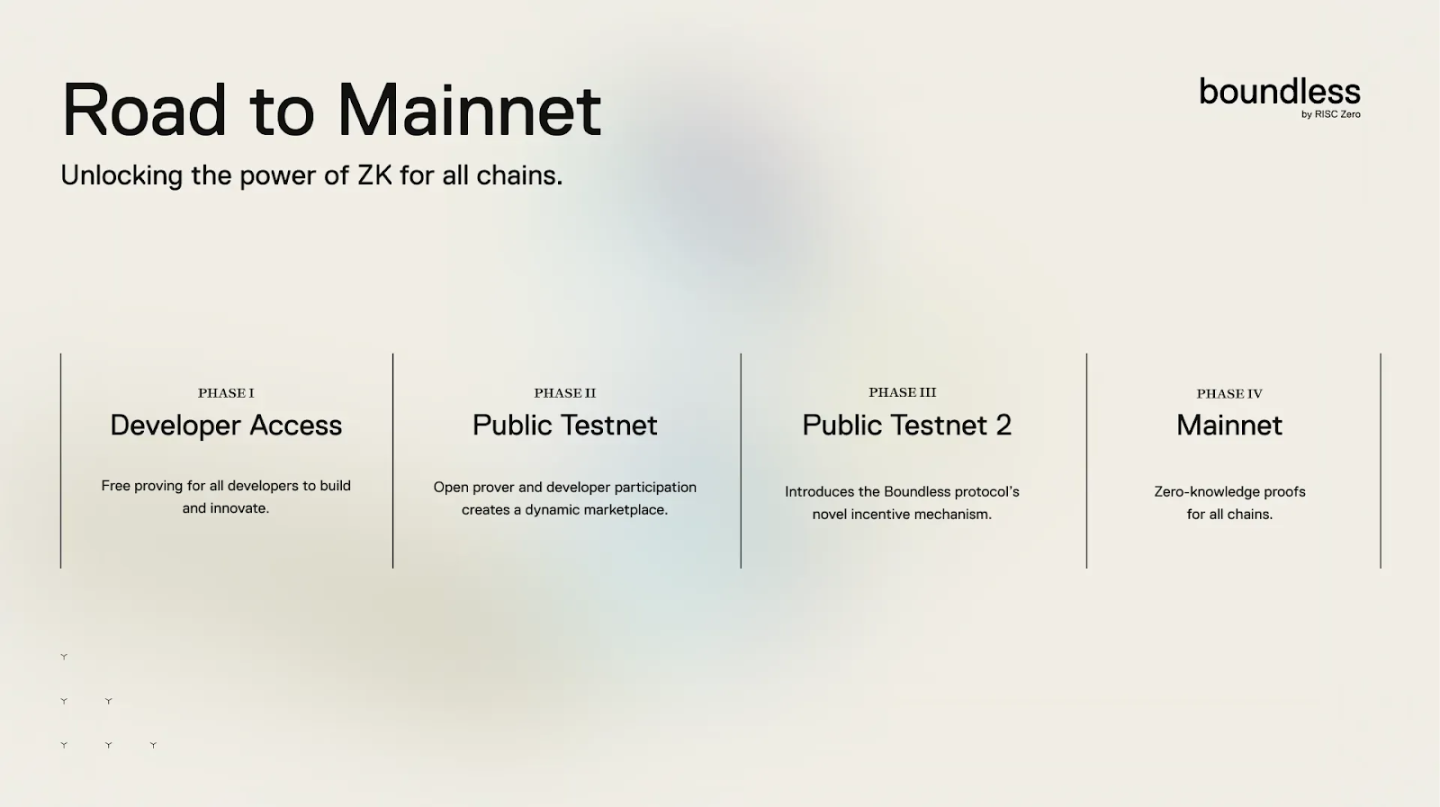
On July 15, 2025, the Boundless mainnet Beta officially launched, entering production on Base. Users can request proofs with real funds, and Prover nodes can access them permissionlessly. A single node supports up to 100 GPUs and participates in bidding. As a demonstration application, the team launched Signal, an open-source ZK consensus client that compresses Ethereum beacon chain finality events into a single zero-knowledge proof that can be directly verified by any chain and contract. This makes Ethereum's final state globally readable, laying the foundation for cross-chain interoperability and secure settlement.
Data from the Boundless browser demonstrates rapid network growth and strong resilience. As of August 18, 2025, the network had processed a cumulative 542.7 trillion computing cycles, completed 399,000 orders, and covered 106 independent programs. The largest single proof exceeded 106 billion computing cycles (August 18), and the network's peak computing power reached 25.93 MHz (August 14), both setting new industry records. Regarding order fulfillment, the average daily number of orders exceeded 15,000 in mid-August, with a peak daily computing power exceeding 40 trillion cycles, demonstrating exponential growth. Furthermore, the order fulfillment success rate has consistently maintained a high level of 98%–100%, demonstrating the maturity of the proof market mechanism. More notably, with intensified prover competition, the cost per cycle has dropped to near zero Wei, signaling the network is entering an era of efficient, low-cost, large-scale computing.
Furthermore, Boundless has attracted active participation from top miners. Leading manufacturers like Bitmain have already begun developing dedicated ASIC mining machines. Companies like 6block, Bitfufu, Force Zone, Intchain, and Nano Labs have joined the network, converting existing mining pool resources into ZK proof computing nodes. This influx of miners is driving Boundless's ZK market towards large-scale industrialization.
7. ZK Coin Token Economic Model Design
ZK Coin (ZKC) is the native token of the Boundless Protocol and the economic and security anchor of the entire network. Its design goal is to build a trusted, low-friction, and scalable zero-knowledge computation market. The total supply of ZKC is 1 billion, with a declining annual inflation mechanism: the annualized inflation rate is approximately 7% in the first year, gradually decreasing to 3% in the eighth year, and remaining stable at this level over the long term. All newly issued tokens are allocated through Proof of Verifiable Work (PoVW), ensuring that issuance is directly tied to real computational work.
Proof of Verifiable Work (PoVW) is Boundless' core innovation, transforming verifiable computation from a technical capability into a measurable, tradable commodity. Traditional blockchains rely on repeated execution across all nodes, limited by the computing power of a single node. PoVW, on the other hand, utilizes zero-knowledge proofs to enable single computations with network-wide verification. It also introduces a trustless measurement system, transforming computational workload into a priceable resource. This allows computation to scale not only on demand but also through market price discovery, service contracts, and incentivized Prover nodes, creating a demand-driven positive cycle. The introduction of PoVW frees blockchains from the scarcity of computing power for the first time, enabling cross-chain interoperability, off-chain execution, complex computations, and privacy protection. It lays the economic and technical foundation for Boundless to build a universal ZK computing infrastructure.
Token Role and Value Capture
ZK Coin (ZKC) is the native token of Boundless and the economic backbone of the entire network:
- Pledge and Collateral: Prover must pledge ZKC (usually ≥10× the maximum request fee) before accepting an order. If the pledge is not delivered within the time limit, the Prover will be fined (50% will be destroyed and 50% will be rewarded to other provers).
- Proof of Verifiable Work (PoVW): Provers earn ZKC rewards by generating zero-knowledge proofs, similar to a mining mechanism. Rewards are distributed as follows: 75% goes to the prover and 25% to the protocol stakers.
- Universal payment layer: The application party uses its own native token (such as ETH, USDC, SOL) to pay for the proof fee, but the prover needs to pledge ZKC, so all proofs are endorsed by ZKC.
- Governance function: ZKC holders can participate in Boundless governance, including market mechanisms, zkVM integration, fund allocation, etc.
Token Distribution (Initial Supply 1 Billion)
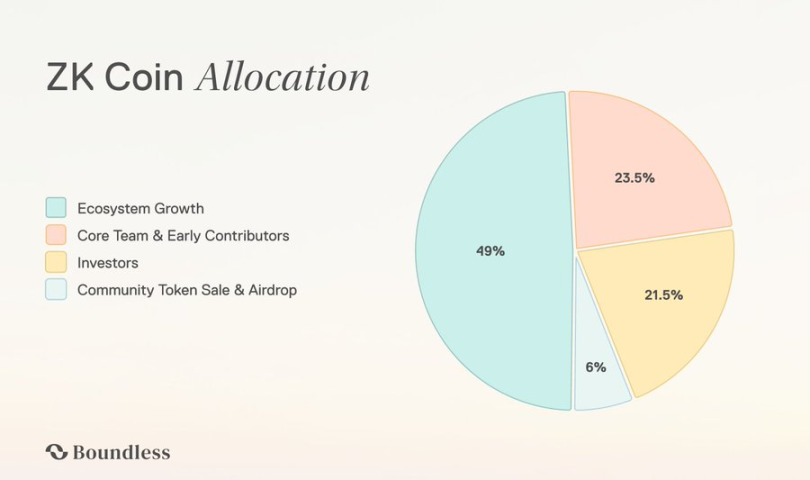
Ecosystem growth (49%)
- 31% Ecosystem Fund: Supports application development, developer tools, education, and infrastructure maintenance; unlocked linearly until the third year.
- 18% Strategic Growth Fund: used for enterprise-level integration, BD cooperation and the introduction of institutional prover clusters; gradually unlocked within 12 months and linked to the results of the cooperation.
Core team and early contributors (23.5%)
- 20% goes to the core team and early contributors, 25% is a one-year cliff, and the remaining is unlocked linearly over 24 months.
- 3.5% is allocated to RISC Zero for zkVM R&D and research funding.
Investors (21.5%): strategic capital and technical supporters; 25% one-year cliff, the remaining two years of linear unlocking.
Community (approximately 6%): Community public offering and airdrop to enhance community participation; 50% of the public offering will be unlocked by TGE, and 50% will be unlocked after 6 months; 100% of the airdrop will be unlocked by TGE.
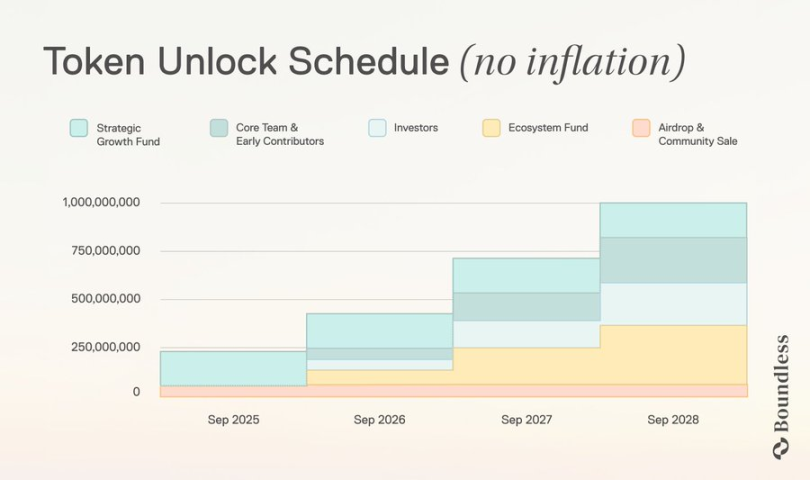
ZKC is the core economic and security anchor of the Boundless Protocol. It serves as collateral guaranteeing proof delivery, ties issuance to real-world workloads through Proof-of-Work (PoVW), and acts as the payment endorsement layer for ZKC across the entire chain. Furthermore, it empowers holders to participate in the protocol's evolution at the governance level. As proof requests increase and the penalty burn mechanism increases, more ZKC is locked up and removed from circulation, creating a long-term value proposition driven by the dual forces of growing demand and shrinking supply.
8. Team Background and Project Financing
The RISC Zero team was founded in 2021. Composed of engineers and entrepreneurs from well-known technology and encryption institutions such as Amazon, Google, Intel, Meta, Microsoft, Coinbase, Mina Foundation, and O(1) Labs, the team has created the world's first zkVM that can run arbitrary code and is building a universal zero-knowledge computing ecosystem based on it.

Jeremy Bruestle – Co-founder & CEO, RISC Zero
Jeremy is a veteran technologist and serial entrepreneur with over 20 years of experience in system architecture and distributed computing. He previously served as a Principal Engineer at Intel, co-founder and Chief Scientist at Vertex.AI, and co-founder and board member at Spiral Genetics. In 2022, he founded RISC Zero and serves as CEO, leading the development and strategy of zkVM technology and promoting the implementation of zero-knowledge proofs in general computing.
Frank Laub – Co-founder & CTO, RISC Zero
Frank has a long history of deep learning compiler and virtual machine technology, having previously worked on deep learning software development at Intel Labs and Movidius, and has accumulated extensive engineering experience at companies such as Vertex.AI and Peach Tech. Since co-founding RISC Zero in 2021, he has served as CTO, leading the development of the zkVM kernel, the Bonsai network, and the developer toolchain.
Shiv Shankar – CEO, Boundless
Shiv has over 15 years of experience in technology and engineering management, spanning various fields including fintech, cloud storage, compliance, and distributed systems. He has served as CEO of Boundless since 2025, leading the product and engineering teams to drive the commercialization of zero-knowledge proofs and the development of cross-chain computing infrastructure.
Joe Restivo – COO, RISC Zero
Joe is a three-time entrepreneur and operations expert with extensive experience in organizational management and risk management. His companies were acquired by Accenture and GitLab, respectively. He teaches risk management at Seattle University's College of Business. He joined RISC Zero in 2023 and serves as COO, responsible for overall operations and scalability.
Brett Carter – VP of Product, RISC Zero
Brett has extensive experience in product management and ecosystem development. He previously worked as a senior product manager at O(1) Labs. He joined RISC Zero in 2023 and is currently the Vice President of Product, responsible for product strategy, ecosystem application implementation, and market integration with Boundless.

In terms of financing, RISC Zero completed a US$40 million Series A financing round in July 2023, led by Blockchain Capital, with Bain Capital Crypto, the lead investor in the seed round, continuing to participate. Other investors include Galaxy Digital, IOSG, RockawayX, Maven 11, Fenbushi Capital, Delphi Digital, Algaé Ventures, IOBC, Zero Dao (Tribute Labs), Figment Capital, a100x and Alchemy.
IX. ZKVM and ZK Market Competitive Analysis
Currently, the leading project offering both zkVM and zkMarketplace is Succinct, which consists of the SP1 zkVM and the Succinct Prover Network (SPN). SP1 is built on RISC-V and is compatible with multiple languages via the LLVM IR front-end. SPN, deployed on Ethereum, distributes tasks through a staking and bidding mechanism, with the $PROVE token providing payment, incentives, and security. In contrast, RISC Zero adopts a dual-engine strategy: on the one hand, Bonsai provides an officially hosted Prover-as-a-Service, offering high performance and stability for enterprise applications; on the other hand, Boundless builds an open, decentralized proof market, allowing any GPU/CPU node to freely join, maximizing decentralization and node coverage, but performance consistency is relatively limited.
Risc Zero takes into account both openness and industrial implementation, while Succinct focuses more on high performance and standardized paths.
Differences and Positioning between Risc Zero (zkVM + Bonsai + Boundless) and Succinct (SP1 zkVM + SPN)

Comparison of RISC-V and Wasm
RISC-V and WASM are the two main approaches to general-purpose zkVM. RISC-V is a hardware-level open instruction set with simple rules and a mature ecosystem, facilitating circuit performance optimization and future-proof hardware acceleration. However, its integration with the traditional web application ecosystem is limited. WASM, on the other hand, is a cross-platform bytecode that naturally supports multi-language and web application migration, and offers a mature runtime. However, due to its stack-based architecture, its performance ceiling is lower than that of RISC-V. Overall, RISC-V zkVM is more suitable for performance and general-purpose computing scalability, while zkWasm offers advantages in cross-language and web scenarios.

10. Summary: Business Logic, Engineering Implementation, and Potential Risks
ZK technology is evolving from a simple scaling tool to a universal foundation for trusted blockchain computing. RISC Zero, leveraging the open RISC-V architecture, transcends EVM reliance, extending zero-knowledge proofs to general off-chain computing. This has also spawned the zk-Coprocessor and decentralized proof marketplaces like Bonsai and Boundless. Together, they build a scalable, tradable, and governable computing trust layer, bringing higher performance, greater interoperability, and broader application scenarios to blockchains.
Of course, the ZK space still faces numerous challenges in the short term: after the primary market hype around ZK peaked in 2023, the launch of mainstream zkEVM projects in 2024 will also drain the secondary market's heat. Furthermore, leading L2 teams often use self-developed provers, and application scenarios like cross-chain verification, zkML, and privacy-preserving computing are still in their early stages, limiting the number of tasks they can match. This means that the order volume of an open proving marketplace is insufficient to sustain a large network, and its value lies more in pre-aggregating prover supply to seize opportunities when demand surges. Meanwhile, while zkVM has a low technical barrier to entry, it's difficult to directly integrate into the Ethereum ecosystem. In the future, it could offer unique complementary value in scenarios like off-chain complex computations, cross-chain verification, and integration with non-EVM chains.
Overall, the evolutionary path of ZK technology has become increasingly clear: from exploring compatibility with the zkEVM, to the emergence of the general-purpose zkVM, and finally to the decentralized proof market represented by Boundless, zero-knowledge proofs are accelerating their commercialization and infrastructure development. While the current phase may still be a testing ground for investors and developers, it holds the key opportunities for the next industry cycle.
Disclaimer: Some content in this article is AI-assisted. While I have made every effort to ensure the authenticity and accuracy of the information and materials, any discrepancies or omissions are deeply regrettable. This article is for research and reference purposes only and does not constitute any investment advice, solicitation, or other form of financial service. Please note that tokens and related digital asset prices are subject to high risk and volatility. Readers should exercise their own discretion and assume all risks before making any investment decisions.
También te puede interesar
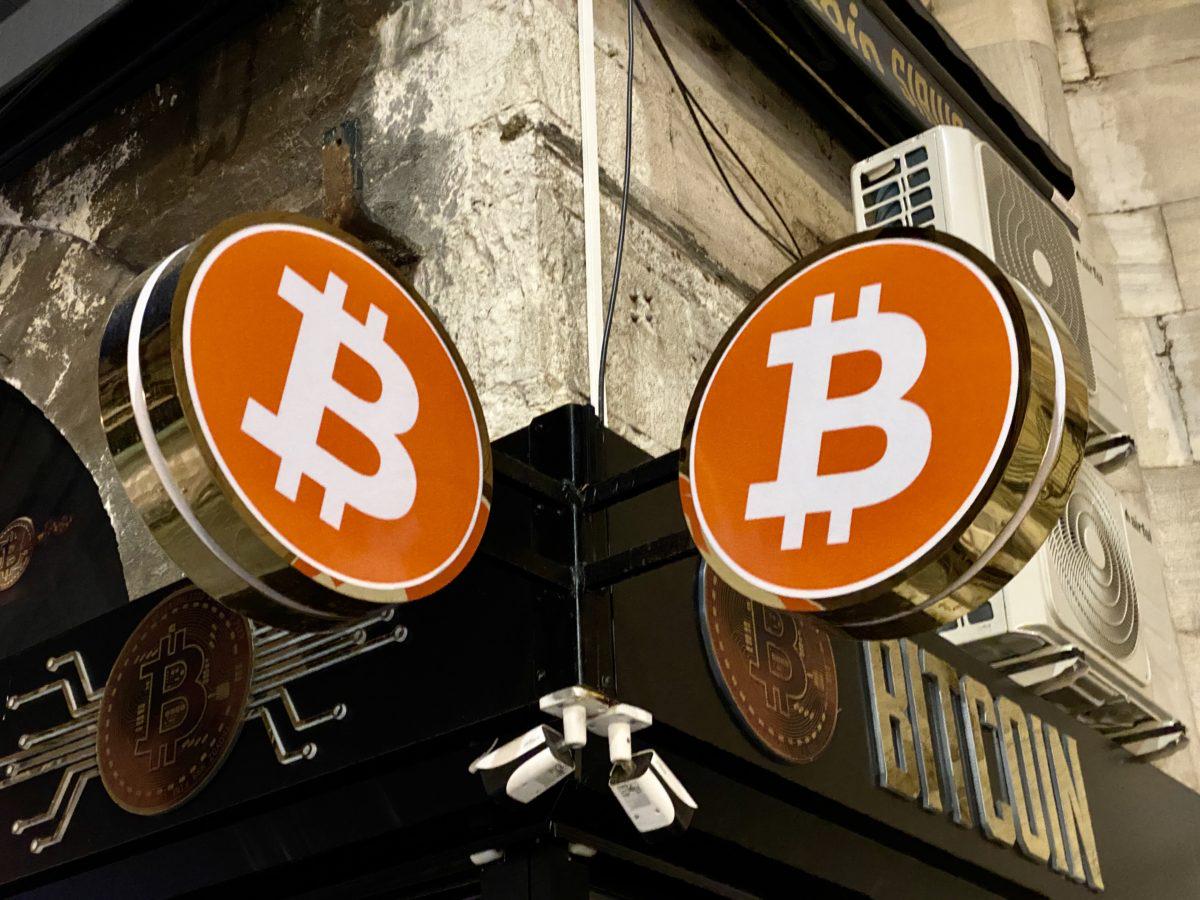
Opinion: Raising funds for listed companies to buy Bitcoin is a "toxic" leverage

Stablecoins and RWA cross-border innovation practices, Shanghai seminar discusses the new financial ecosystem
